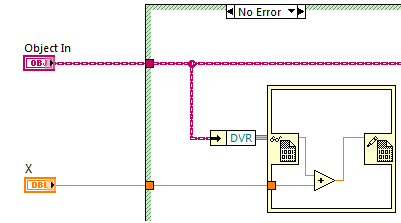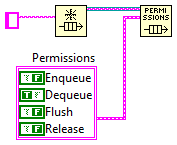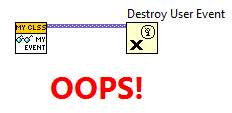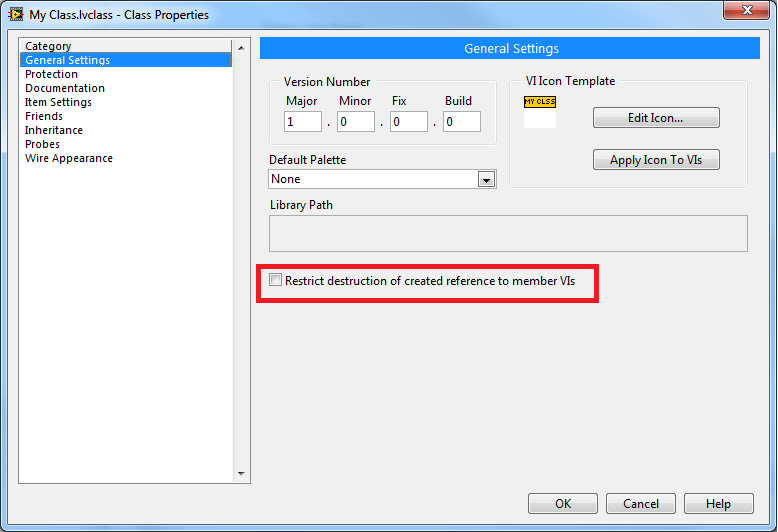-
Posts
2,872 -
Joined
-
Last visited
-
Days Won
45
Content Type
Profiles
Forums
Downloads
Gallery
Everything posted by Yair
-

How to call PostLVUserEvent() with a cluster of scalars from C++?
Yair replied to Yair's topic in Calling External Code
I get the feeling that when we tested earlier in the week, there was some mix up when we working back and forth, because one of the older DLLs which was supposed to have an int and didn't work, was actually returning float data, so when I replaced the I32 with a SGL, that code started to work fine. -

How to call PostLVUserEvent() with a cluster of scalars from C++?
Yair replied to Yair's topic in Calling External Code
OK, I'm not sure why, but he says that now it seems to be working regardless of which packing he sets. Here's an example which includes an 8.6 VI, the C++ source and a DLL compiled in Visual Studio 2008. This seems to work fine, but, as I understand it, isn't essentially different from what we did earlier in the week, so I'm not sure why it didn't work then. When you run the example, you should get a running counter in the int and 1.1 in the other two. Thanks. DLL LV Event.zip -

How to call PostLVUserEvent() with a cluster of scalars from C++?
Yair replied to Yair's topic in Calling External Code
It is indeed VC++, so the alignment may well be the issue. I relayed the info to the C++ guy and hopefully by tomorrow I should have an answer. AQ, I think he simply copied the example code and then added the struct, since the second parameter for the function is supposed to be LV data. In the case of the test code with the ints, it looks like this: typedef struct _EventSend { _EventSend() { dwMask = 0; iA = 0; iB = 0; } DWORD dwMask; int iA; int iB; } EVENT_SEND; EVENT_SEND eventF; // snip... //The code is actually supposed to work with several devices, so we keep several event references in an array PostLVUserEvent(*(lvUserEventRef[iDevice]),(void *)&eventF); } [/CODE] Once we get it working, I'll get him to create example code which (if you want) I can then send you so that you incorporate it into the original document (or I can add a comment there with a link). -

Lifetime of a reference of .NET constructor
Yair replied to FraggerFox's topic in Calling External Code
No, I'm pretty sure what you're describing should work. The only things I can think of are either that you have a bug or that .NET behaves differently. The only thing I can suggest at the moment is the same thing that Rolf did (assuming it's possible in your case) - check the reference inside the LV2G and if there's an error, get a new reference. -

How to call PostLVUserEvent() with a cluster of scalars from C++?
Yair replied to Yair's topic in Calling External Code
Good point. I know that LV aligns to 1 byte on Windows, but I don't know what the C++ code does, so I'll be sure to look at it tomorrow. Hopefully that's the the issue. -
I'm working with a C++ programmer and trying to get some data into LV. We've looked at the examples for PostLVUserEvent() both on NI's site (here) and on LAVA and managed to get events in LV. The problem is that the event data is a struct with a DWord and a few floats or doubles and for some reason when we try to create an equivalent LV cluster (a U32 and SGLs or DBLs) the first integer gets through fine, but the floating points values are completely meaningless. We also did a quick test with a cluster with just three INTs and we still only get the value for the first one - the other two are always zero. I don't have the code at the moment (and it's too messy anyway at the moment), but does anyone know what would be the correct C/C++ code to get the event reference from LV (although that part seems to work fine) and to send an event of a struct with a few scalars (preferably with doubles as well)?
-

Lifetime of a reference of .NET constructor
Yair replied to FraggerFox's topic in Calling External Code
If you call the init case in the new hierarchy, you'll get a new reference, which is owned by the new hierarchy, and presumably replaces the original reference, since you only have a single shift register to hold the reference. Once the hierarchy goes idle, the new reference is automatically cleared and you get your error. -

Lifetime of a reference of .NET constructor
Yair replied to FraggerFox's topic in Calling External Code
It doesn't need to just be "calling" the VI. It has to be the first one calling the VI, because the hierarchy which controls the lifetime of a reference is the hierarchy it was created in. Another option which might be relevant is that somewhere you close the reference explicitly. -
Ah, yes, I keep forgetting about that trick. In any case, as you both said, the event is still exposed and I don't think a better case could be made for not exposing the reference than for limiting it (and it has some other issues). Now that the discussion has been turned around to this, I remembered that there was already an idea along these lines in the IE. A quick search brought up this, which hardly anyone (including me) voted for. What does that mean? I don't know, but it's another thing to think about.
-
That's interesting, because I see it in exactly the opposite way - the event registration node HAS to be associated with the specific event structure (because the event registration refnum is strictly typed and holds all the events and because splitting the registration refnum to more than one structure creates undefined and buggy behavior), so you have to provide the event reference (or create a member VI for every single type of event structure which will ever be used by someone who uses the event, something which is obviously impossible). Since you have to do that, locking the event reference makes sense and solves the basic issue. For the DVR, it should be theoretically simple to create a member VI for any type of interaction you want to allow with the DVR, such as this VI which adds: There is one additional option - rather than restricting this to registration-only events, we could introduce a new Set Reference Permissions node, which will allow you to set specific permissions for a reference: This would cause subsequent nodes to return errors if they do not have those permissions. Of course, such a change is considerably more extensive and I don't see it happening, because we do have another solution (one which is also arguably better).
-

SubVI with modal window behavior/window appearance
Yair replied to DaVinzi's topic in User Interface
First, Welcome to LAVA. Second, The properties of the subVI should definitely be remembered in the application if you customized them. Assuming things are working correctly, you should only see something like this under specific circumstances: The main VI is also modal. This shouldn't actually make difference, because if both are modal, the subVI should "win". You change the properties of the VI in code. You changed the properties of the VI when building the application. This also doesn't seem likely, because it would require explicit actions, but it's also something I would check. It should be found in the Source Files Settings page of the app builder. Selecting the VI and clicking the customize button allows you to change these settings for the build, but again, that should not be needed. I would suggest you check all of these to see if they apply. If not, uploading the code should help, or you could also try starting from scratch (e.g. create a new build spec just to test this). -
You bring up a good point which I haven't considered originally, which is that closing the reference is not the only way to abuse it. Other VIs can do all kinds of things with it once they have it and there is no way of creating a single API to define all the restrictions you would want to place. You're probably right that user events are the only API really affected by this (DVRs could also be, since they also use a structure, but it should probably always be possible to create a member VI which will do the deref-reref actions and have the external VI call that). I'll consider it some more, but if I'll post anything, it will probably be a request for the register-only event reference. Of course, for something like that you need to ask how the reference is destroyed (e.g. maybe it can only be destroyed when the "real" reference is closed).
-
OK, I added an idea for this - http://forums.ni.com/t5/LabVIEW-Idea-Exchange/Add-a-property-to-guarantee-that-the-front-panel-of-a-VI-will/idi-p/1779268
-
No, it just needs to log which VI creates each reference (something which may well already happen today, since LV knows which hierarchy owns the reference). But what if you want the library to provide an event people can register for? You can't expose that as anything other than an event reference. As for the external reference pushed into the library, it wasn't created by the library and therefore would not be protected by this option.
-
Actually, those are move one. Move all the way require Shift as well.
-
I want to post the following idea to the IE, but before I do, I would like some feedback. There are times when we might want to expose a reference from inside a library (e.g. a queue or an event which will provide some data to someone), but doing so allows the non-member VI to close the reference: In some cases this can be avoided (e.g. in the queue case you can output an object and a wrapper around the dequeue primitive, so that the caller doesn't have the queue reference and can't destroy it), but this can't be always avoided (e.g. the event reference). For such cases I would like to propose that libraries gain a new option: When this option is checked, any function which closes a reference (close reference, close file, release queue, etc.) will check if the reference was created in a member VI and in that case will only close the reference if it is called from a member VI. If it's called from another VI, it will not close the reference and will instead return an error. This will allow libraries to guarantee that references that they created remain valid as long as they don't close them explicitly. A couple of comments: The example shows a class, but this should probably apply to all classes. At least XControls can probably gain from this. Named references will behave like other references, so if you open two references to the same notifier, one inside the library and one outside it, the one opened outside it can be destroyed by anyone (although I'm not sure how the Force Destroy input should behave in such a scenario. Does anyone have thoughts on this?). What do people think of this?
-
Your image wasn't attached, but in general, the Z-order of front panel objects is controlled by the reorder button: So just select the decoration and then move it all the way to the back.
-
Like asbo said, you need to open the VI. Looking at it now, I can see that arg 8 is flow control.
-
NI has a Modbus library for LabVIEW - http://zone.ni.com/devzone/cda/epd/p/id/4756 You'll need to find the relevant registers and coils for the device yourself in the device documentation.
-
The error comes not from the VI itself, but from the property node inside the VI. The arguments in the property node go from top to bottom (i.e. the top argument is argument 1). You can count down to 8 to see what's the property that's returning the error (although I don't know if that will help you. USB to serial adapters are notorious for having problems and it's possible you might need to reinstall its driver or get another one).
-
I have no experience with something like this, so there may be better ways, but if you open the log window, you can select multiple revisions (using the Ctrl or Shift keys) and then right click and copy to the clipboard. I believe this copies all the relevant data to the clipboard, which you can then parse and re-format using LV.
-
There's certainly no technical reason. I'm guessing that no one ever thought of it, because usually it's not needed (i.e. either the VI doesn't need its FP or it has the FP included due to the normal configuration of the code, such as having the FP set to open when called). The build configuration dialog does allow you to override the remove-FP setting for every VI, but I don't like that, because it's very hidden and you have to set it for each build separately. If you add an idea for such a VI property to the IE I would certainly vote for it.
-
With one important difference - it's much easier to document why you have an unused property by placing a comment next to it than to safely document why the scroll bars are hidden (safely = in a way which will make it unlikely that someone will accidentally change it).






